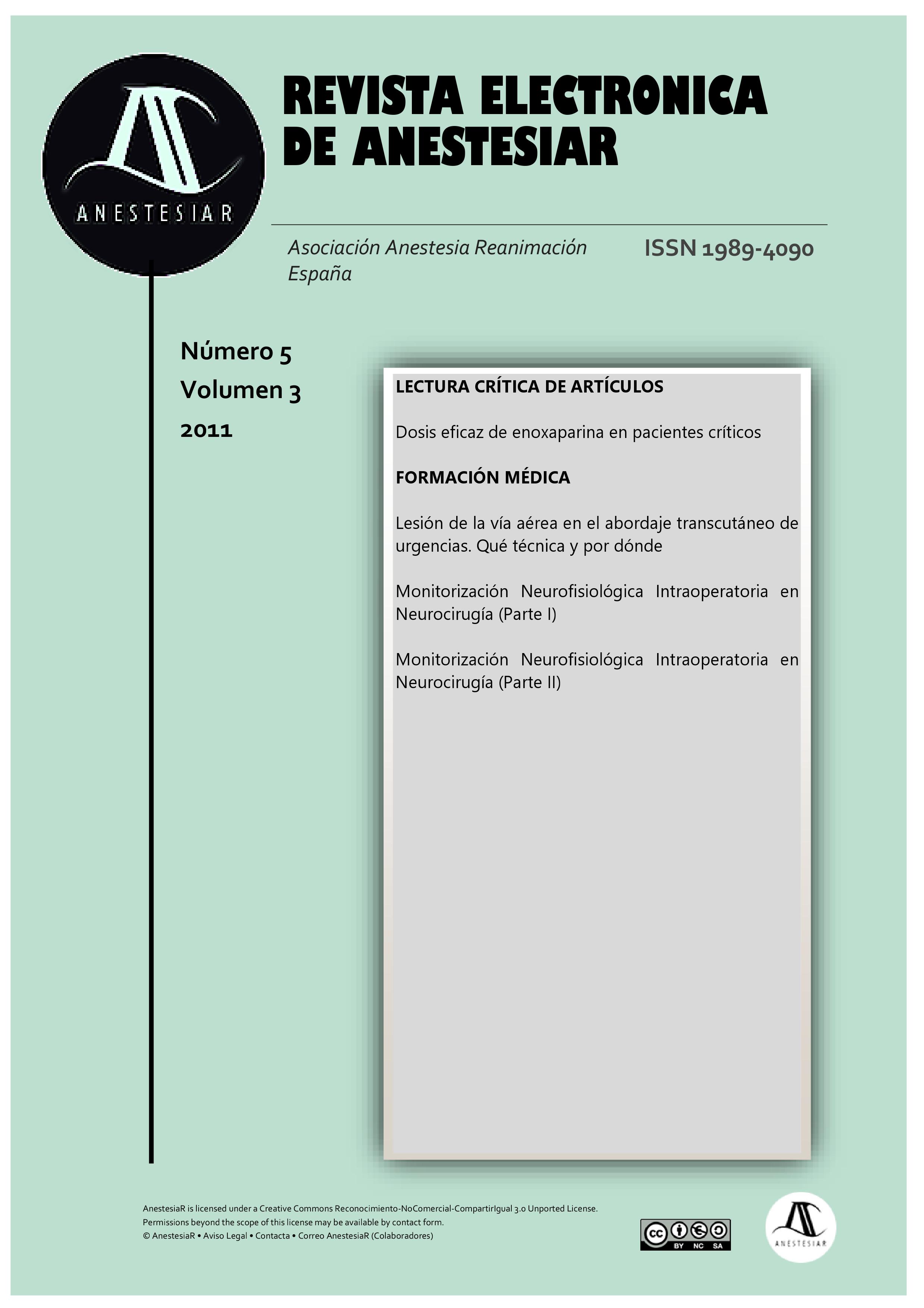Dosis eficaz de enoxaparina en pacientes críticos
Robinson S, Zincuk A, Strom T, Larsen TB, Rasmussen B, Toft P. Enoxaparin-effective dosage for intensive care patients: double-blinded, randomised clinical trial. Critical Care 2010.14:R41.
DOI:
https://doi.org/10.30445/rear.v3i5.443Keywords:
críticos, enoxaparina, reanimación, Tromboembolismo, trombosisAbstract
El paciente crítico está especialmente predispuesto a sufrir tromboembolismos por muy diversos factores: fallo cardíaco, traumatismos, sepsis, cáncer, edad avanzada, obesidad, inmovilización, ventilación mecánica, monitorización invasiva. La prevalencia de trombosis venosa profunda entre los pacientes que no reciben profilaxis se encuentra entre el 10-80%.
References
1.- Geerts WH, Bergqvist D, Pineo GF et al. American College of Chest Physicians: Prevention of venous thromboembolism: American College of Chest Physicians Evidence-Based Clinical Practice Guidelines (8th Edition). Chest 2008, 133: 381S-453S.
2.- Geerts W, Selby R: Prevention of venous thromboembolism in the ICU. Chest 2003, 124: 357S-363S.
3.- Attia J, Ray JG, Cook DJ, Douketis J, Ginsberg JS, Geerts WH: Deep vein thrombosis and its prevention in critically ill adults. Arch Intern Med 2001, 161: 1268-1279.
4.- Leizorovicz A, Mismetti P: Preventing venous thromboembolism in medical patients. Circulation 2004, 110: IV13-IV19.
5.- Cook D, Douketis J, Meade M et al. Canadian Critical Care Trials Group: Venous thromboembolism and bleeding in critically ill patients with severe renal insufficiency receiving dalteparin thromboprophylaxis: prevalence, incidence and risk factors. Crit Care 2008, 12: R32.
6.- Mayr AJ, Dünser M, Jochberger S et al. Antifactor Xa activity in intensive care patients receiving thromboembolic prophylaxis with standard doses of enoxaparin. Thromb Res 2002,105: 201-204.
7.- Dörffler-Melly J, de Jonge E, Pont AC et al. Bioavailability of subcutaneous low-molecular-weight heparin to patients on vasopressors. Lancet 2002, 359: 849-850.
8.- Levine MN, Planes A, Hirsh J, Goodyear M, Vochelle N, Gent M: The relationship between anti-factor Xa level and clinical outcome in patients receiving enoxaparine low molecular weight heparin to prevent deep vein thrombosis after hip replacement. Thromb Haemost 1989, 62: 940-944.
9.- Cook D, Crowther M, Meade M et al. Deep venous thrombosis in medical-surgical critically ill patients: prevalence, incidence, and risk factors. Crit Care Med 2005, 33: 1565-1571.
10.- Rabbat CG, Cook DJ, Crowther MA et al. Dalteparin thromboprophylaxis for critically ill medical-surgical patients with renal insufficiency. J Crit Care 2005, 20: 357-363.
11.- Scholey GM, Saayman AG, Hingston DH, Wise MP: Renal function and thromboprophylaxis in critically ill patients. Critical Care 2010, 14:416.
2.- Geerts W, Selby R: Prevention of venous thromboembolism in the ICU. Chest 2003, 124: 357S-363S.
3.- Attia J, Ray JG, Cook DJ, Douketis J, Ginsberg JS, Geerts WH: Deep vein thrombosis and its prevention in critically ill adults. Arch Intern Med 2001, 161: 1268-1279.
4.- Leizorovicz A, Mismetti P: Preventing venous thromboembolism in medical patients. Circulation 2004, 110: IV13-IV19.
5.- Cook D, Douketis J, Meade M et al. Canadian Critical Care Trials Group: Venous thromboembolism and bleeding in critically ill patients with severe renal insufficiency receiving dalteparin thromboprophylaxis: prevalence, incidence and risk factors. Crit Care 2008, 12: R32.
6.- Mayr AJ, Dünser M, Jochberger S et al. Antifactor Xa activity in intensive care patients receiving thromboembolic prophylaxis with standard doses of enoxaparin. Thromb Res 2002,105: 201-204.
7.- Dörffler-Melly J, de Jonge E, Pont AC et al. Bioavailability of subcutaneous low-molecular-weight heparin to patients on vasopressors. Lancet 2002, 359: 849-850.
8.- Levine MN, Planes A, Hirsh J, Goodyear M, Vochelle N, Gent M: The relationship between anti-factor Xa level and clinical outcome in patients receiving enoxaparine low molecular weight heparin to prevent deep vein thrombosis after hip replacement. Thromb Haemost 1989, 62: 940-944.
9.- Cook D, Crowther M, Meade M et al. Deep venous thrombosis in medical-surgical critically ill patients: prevalence, incidence, and risk factors. Crit Care Med 2005, 33: 1565-1571.
10.- Rabbat CG, Cook DJ, Crowther MA et al. Dalteparin thromboprophylaxis for critically ill medical-surgical patients with renal insufficiency. J Crit Care 2005, 20: 357-363.
11.- Scholey GM, Saayman AG, Hingston DH, Wise MP: Renal function and thromboprophylaxis in critically ill patients. Critical Care 2010, 14:416.
Published
2011-05-31
How to Cite
Estruch Pons, I., Serna Gandía, M. B., & Paz Martín, D. (2011). Dosis eficaz de enoxaparina en pacientes críticos: Robinson S, Zincuk A, Strom T, Larsen TB, Rasmussen B, Toft P. Enoxaparin-effective dosage for intensive care patients: double-blinded, randomised clinical trial. Critical Care 2010.14:R41. Revista Electrónica AnestesiaR, 3(5), 1. https://doi.org/10.30445/rear.v3i5.443
Issue
Section
Critical reviews of articles



 Revista Electrónica AnestesiaR by
Revista Electrónica AnestesiaR by 